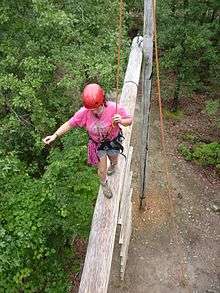Boy Scouts of America
| Boy Scouts of America | |||
|---|---|---|---|
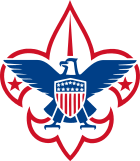 | |||
| Age range |
| ||
| Headquarters | Irving, Texas | ||
| Location | United States, Puerto Rico, USVI, Europe, Japan | ||
| Country | United States | ||
| Founded | February 8, 1910 | ||
| Founders | |||
| Membership | |||
| Chief Scout Executive | Michael B. Surbaugh | ||
| President | Randall L. Stephenson | ||
| National Commissioner | Charles W. Dahlquist | ||
| Affiliation | World Organization of the Scout Movement | ||
| Governing body | National Executive Board | ||
|
| |||
|
Website scouting | |||
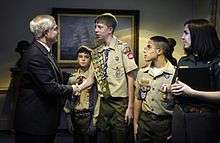
The Boy Scouts of America (BSA) is one of the largest youth organizations in the United States, with more than 2.4 million youth members and nearly one million adult volunteers.[3] Since its founding in 1910 as part of the international Scout Movement, more than 110 million Americans have been at some point members of the BSA.[4]
The BSA's goal is to train youth in responsible citizenship, character development, and self-reliance through participation in a wide range of outdoor activities, educational programs, and, at older age levels, career-oriented programs in partnership with community organizations. For younger members, the Scout method is part of the program to instill typical Scouting values such as trustworthiness, good citizenship, and outdoors skills, through a variety of activities such as camping, aquatics, and hiking.[5][6] In order to further these outdoor activities, the BSA has four high-adventure bases that operate in Florida, Minnesota, New Mexico, West Virginia, Manitoba, and Ontario.
The BSA is a constituent member of the World Organization of the Scout Movement. The traditional Scouting divisions are Cub Scouting for boys ages 7 to 10½ years, Boy Scouting for boys ages 10½ to 18 and Venturing for young men and women ages 14 (or 13 and having completed the 8th grade) through 21. Learning for Life is a non-traditional subsidiary that provides in-school and career education.[7][8] The BSA operates traditional Scouting by chartering local organizations, such as churches, clubs, civic associations, or educational organization, to implement the Scouting program for youth within their communities. Units are led entirely by volunteers appointed by the chartering organization, who are supported by local councils using both paid Professional Scouters and volunteers.
Origins
The progressive movement in the United States was at its height during the early 20th century.[9] With the migration of families from farms to cities, there were concerns among some people that young men were no longer learning patriotism and individualism. The YMCA was an early promoter of reforms for young men with a focus on social welfare and programs of mental, physical, social and religious development.[10]:72–82
Precursors
BSA had two notable predecessors in the United States: the Woodcraft Indians started by Ernest Thompson Seton in 1902 in Cos Cob, Connecticut, and the Sons of Daniel Boone founded by Daniel Carter Beard in 1905 in Cincinnati, Ohio.[11] In 1907, Robert Baden-Powell, founded the Scouting movement in England using elements of Seton's works among other influences.[12] Several Scout programs for boys started independently in the US. (see Scouting in the United States). Many of these Scout programs in the US merged with the BSA.[13]:52
Founding of the Boy Scouts of America
In 1909, Chicago publisher W. D. Boyce was visiting London, where he encountered a boy who came to be known as the Unknown Scout.[14] Boyce was lost on a foggy street when an unknown Scout came to his aid, guiding him to his destination. The boy then refused Boyce's tip, explaining that he was a Boy Scout and was merely doing his daily good turn. Interested in the Boy Scouts, Boyce met with staff at the Boy Scouts Headquarters and, by some accounts, Baden-Powell. Upon his return to the US, Boyce incorporated the Boy Scouts of America on February 8, 1910.[15] Edgar M. Robinson and Lee F. Hanmer became interested in the nascent BSA and convinced Boyce to turn the program over to the YMCA for development in April 1910. Robinson enlisted Seton, Beard, Charles Eastman, and other prominent leaders in the early youth movements. Former president Theodore Roosevelt, who had long complained of the decline in American manhood, became an ardent supporter.[16] In January 1911, Robinson turned the movement over to James E. West who became the first Chief Scout Executive and Scouting began to expand in the US[10]:148
The BSA's stated purpose at its incorporation in 1910 was "to teach [boys] patriotism, courage, self-reliance, and kindred values."[4]:7 Later, in 1937, Deputy Chief Scout Executive George J. Fisher expressed the BSA's mission: "Each generation as it comes to maturity has no more important duty than that of teaching high ideals and proper behavior to the generation which follows."[17] The current mission statement of the BSA is "to prepare young people to make ethical and moral choices over their lifetimes by instilling in them the values of the Scout Oath and Law."[5] The Church of Jesus Christ of Latter-day Saints was the first partner to sponsor Scouting in the United States, adopting the program in 1913 as part of its Mutual Improvement Association program for young men.[18]
Federally chartered corporation
The purposes of the corporation are to promote, through organization, and cooperation with other agencies, the ability of boys to do things for themselves and others, to train them in scoutcraft, and to teach them patriotism, courage, self-reliance, and kindred virtues, using the methods that were in common use by boy scouts on June 15, 1916.
The BSA holds a Congressional charter under Title 36 of the United States Code,[19] which means that it is one of the comparatively rare "Title 36" corporations in the United States.[20] On behalf of the BSA, Paul Sleman, Colin H. Livingstone, Ernest S. Martin, and James E. West successfully lobbied Congress for a federal charter for the BSA which President Woodrow Wilson signed on June 15, 1916. One of the principal reasons for seeking a Congressional Charter was as a way to deal with competition from other Scout organizations including the United States Boy Scouts and the Lone Scouts of America,[21] The 1916 statute of incorporation established this institution among a small number of other patriotic and national organizations which are similarly chartered,[22] such as the Girl Scouts of the USA, the American Legion, the Red Cross, Little League Baseball, and the National Academy of Sciences. The federal incorporation was originally construed primarily as an honor; however, it does grant the chartered organization some special privileges and rights, including freedom from antitrust and monopoly regulation and complete control over the organization's symbols and insignia.[23] The special recognition neither implies nor accords Congress any special control over the BSA, which remains free to function independently.[24]
Membership
Traditional membership
In the BSA, Scouting is considered to be one movement with four main programs:
- Cub Scouting is available to boys from first to fifth-grade or 7 to 11 years.[25]
- Boy Scouting is the flagship program of the BSA generally for boys ages 11 to 18. [25]
- Venturing is the program for young men and women ages 14 through 21.[25]
- Sea Scouting is the program for young men and women ages 14 through 21 focused on nautical activities.[26]
There are about 100,000 physically or mentally disabled Scouts throughout the United States. Anyone certified as disabled "may enroll in Scouting and remain in its program beyond the regulation age limits. This provision allows all members to advance in Scouting as far as they wish."[8] Advancement is measured by the achievement to the best of the Scout's abilities.
Other programs
The Boy Scouts of America offers several other programs and subprograms beyond the traditional membership:
- Varsity Scouting is a sub-division of Boy Scouting available to boys ages 14 to 18; it adds a program of high adventure and sporting activities.[27]
- The Order of the Arrow is the Boy Scouting national honor society for experienced campers, based on American Indian traditions and is dedicated to the ideals of brotherhood and cheerful service.[28]
- Lone Scouting is a program designed to allow those who would otherwise not be able to become Boy Scouts or Cub Scouts—usually due to residence in an overseas, isolated, or unsafe community—to participate in the Scouting experience.
- STEM Scouts is a pilot program of the BSA that focuses on STEM learning and career development for boy and girls in elementary, middle, and high school.[29][30]
Learning for life
Learning for Life is a school and work-site based program that is a subsidiary of the BSA. It utilizes programs designed for schools and community-based organizations that are designed to prepare youth for the complexities of contemporary society and to enhance their self-confidence, motivation, and self-esteem.[31] Exploring is the worksite-based program of Learning for Life with programs based on five areas of emphasis: career opportunities, life skills, citizenship, character education, and leadership experience.[32]
Learning for Life is not considered a traditional Scouting program; it does not use the Scout Promise, Scout Law, uniforms, or insignia of traditional Scouting. All Learning for Life programs are open to youth and adults without restriction based on gender, residence, sexual orientation, or other considerations other than age requirements.[32][33]
Membership controversies
Unlike the BSA's Learning for Life, membership in the traditional BSA programs is more restricted and controversial. Girls may not join Cub Scouting or Boy Scouting, but may join Venturing and Sea Scouting; women can be adult volunteers in all programs. Today, the BSA does not prohibit gay and lesbian adults or youth from participation. The BSA does prohibit members who are atheist and agnostic based on its "Duty to God" principle.[34][35][36][37]
In 2000, the Supreme Court ruled in Boy Scouts of America v. Dale that Boy Scouts, and all similar private voluntary organizations, have the constitutionally protected right under the First Amendment of freedom of association to set membership standards.[38] In 2004, the BSA adopted a new policy statement, including a "Youth Leadership" policy that disallowed members to continue in leadership positions in the event they were to hold themselves out as "open and avowed homosexuals."[39]
At the Scouts annual meeting in April 2012, a leader from the Northeast presented a resolution that "would allow individual units to accept gays as adult leaders".[40][41] However, in July 2012, at the culmination of a review started in 2010, an 11-person committee convened by the BSA reached a "unanimous consensus" recommending retaining the current policy.[42][43] Intel,[44] UPS,[45] and Merck[46][47] cut financial ties with the BSA over the policy decision. Within the BSA National Executive Board, members James Turley, CEO of Ernst & Young, and Randall Stephenson, CEO of AT&T and who was then "on track to become president of the Scout's national board in 2014"[48] and later was, publicly opposed the policy and stated their intention "to work from within the BSA Board to actively encourage dialogue and sustainable progress" in changing the policy.[49] On January 28, 2013, the BSA announced they were considering rescinding the ban on homosexuals, allowing chartered organizations to determine local policy.[50]
On May 23, 2013, 61% of the 1,400-member BSA National Council voted to remove the restriction denying membership to youth on the basis of sexual orientation while emphasizing that any sexual conduct, whether heterosexual or homosexual, is not allowed. The resolution went into effect on January 1, 2014,[51][52] but Scout leaders who were "open and avowed homosexuals" were still prohibited. The policy specifically states that BSA does not inquire into a person's sexuality.[53] Gay rights groups hailed the decision, but vowed to press on until all gay members were accepted. Some churches and conservative members threatened to quit the Boy Scouts in response.[54] On June 12, 2013, the Southern Baptist Convention passed non-binding resolutions urging the BSA not to change their policy.[55][56] In September 2013, a new Scouting group called Trail Life USA was created.[57][58][59] Subsequently, some Christian denomination congregations replaced their Boy Scouts of America troops with those of Trail Life USA.[60]
In May 2015, Boy Scouts of America President Robert Gates said it was time to end the ban on gay leaders. Gates said, it “cannot be sustained,” any longer. On July 10, 2015, the Boy Scouts of America Executive Committee agreed, and referred the matter to the National Executive Board.[61] On July 27, 2015, the Boy Scouts of America National Executive Board voted to lift the organization's blanket ban on openly gay leaders and employees. Local chartering organizations are still permitted to set their own standards based on religious principle for selecting the adult volunteers for their unit.[62]
Program
Aims, methods, and ideals
"On my honor, I will do my best, to do my duty, to God and my country, and to obey the Scout Law, to help other people at all times, to keep myself physically strong, mentally awake, and morally straight." -Scout Oath
"A Scout is trustworthy, loyal, helpful, friendly, courteous, kind, obedient, cheerful, thrifty, brave, clean, and reverent." -Scout Law
The objectives of the BSA are referred to as Aims of Scouting: moral character development; citizenship training; and development of physical, mental, and emotional fitness.[63] The BSA pursues these aims through an informal education system called the Scout method, with variations that are designed to be appropriate for the age and maturity of each membership division.[5][64] Each unit is sponsored by a community organization as part of their youth program and is involved in the neighborhood and community.
Cub Scouts wear a uniform that gives each boy a level of identity within the den, the pack and the community. The boys learn teamwork by meeting and working together in a den of four to ten boys under adult leadership. They learn and apply the ideals codified in the Cub Scout Promise and the Law of the Pack,[65] and in the Character Connections program that develops the core values of citizenship, compassion, cooperation, courage, faith, health and fitness, honesty, perseverance, positive attitude, resourcefulness, respect and responsibility.[66] The advancement system uses both age-based ranks and an optional Academics and Sports Program designed for the development of physical, mental and emotional fitness.[67][68] Most advancement is done in the home and is intended to involve the entire family and many Cub Scout activities include family members.
Boy Scouts learn to use the ideals spelled out in the Scout Oath, the Scout Law, the Outdoor Code, the Scout motto ("Be prepared"), and the Scout slogan ("Do a good turn daily"). They wear a uniform and work together in patrols of four to ten boys with an elected patrol leader. Scouts share responsibilities, apply skills learned at meetings and live together in the outdoors. The advancement system provides opportunities for personal growth and self-reliance.[69] Scouts interact with adult leaders who act as role models and mentors, but they are expected to plan their own activities within the troop and to participate in community service. Opportunities are provided for leadership training with practical application.
Venturers are expected to know and live by the Venturing Oath and Venturing Code.[70] They associate and work directly with adults as partners, but the crew is led by elected youth officers who are given opportunities to learn and apply leadership skills. Venturers plan and participate in interdependent group experiences dependent on cooperation. An emphasis on high adventure provides opportunities for team-building and practical leadership applications. A series of awards provide opportunities for recognition and personal growth.[71] Each award requires the Venturer to teach what they have learned to others returning the skill and knowledge back to the community and enabling the Venturer to master those skills.
In October 2012, the National Council announced that, as a result of the findings and recommendations of a select committee made up of volunteer Scouters, the Cub Scout and Venturing programs would transition to use of the Boy Scout Oath and Promise, and in the case of the Venturers, the Boy Scout three-finger salute and sign as well. The Venturing change will occur in late 2013 or early 2014; the Cub Scout change will take effect in mid-2015.
Eagle Scout
A Scout who attains this rank is called an Eagle Scout. Since its introduction in 1911, the Eagle Scout rank has been earned by more than two million young men. Requirements include earning at least 21 merit badges and demonstrating Scout Spirit through the Boy Scout Oath and Law, service, and leadership. This includes an extensive service project that the Scout plans, organizes, leads, and manages. Eagle Scouts are presented with a medal and a badge that visibly recognizes the accomplishments of the Scout. Additional recognition can be earned through Eagle Palms, awarded for completing additional tenure, leadership, and merit badge requirements. Many famous Americans are Eagle Scouts: astronaut Neil Armstrong, film director Michael Moore, TV host Mike Rowe, Steven Spielberg, Mayor Michael Bloomberg, Secretary of Defense Robert Gates, and President Gerald Ford are just a small sample of Eagle Scouts.
National Scout jamboree
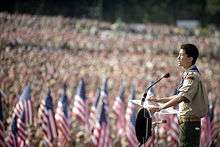
The national Scout jamboree is a gathering of Boy Scouts from across the US. It is usually held every four years, with some adjustment for special years such as the 2010 National Scout Jamboree that celebrated the BSA centennial. The first jamboree was held in 1937 at the Washington Monument in Washington, D.C.[72] Since then, jamborees have been held in varying locations. Beginning in 1981, the jamboree has been held at Fort A.P. Hill, Virginia. A permanent location owned by the BSA was sought in 2008 for future jamborees, high adventure programs and training. The Summit Bechtel Family National Scout Reserve near Beckley, West Virginia is now the permanent site beginning with the 2013 National Scout Jamboree.[73]
High adventure
The Boy Scouts of America operates several high adventure bases at the national level. Each offers a wide range of programs and training— a typical core program may include sailing, wilderness canoeing or wilderness backpacking trips. These bases are administered by the High Adventure Division of the National Council.
Current high-adventure bases of the Boy Scouts of America include Philmont Scout Ranch, Northern Tier National High Adventure Bases, Florida National High Adventure Sea Base, and The Summit Bechtel Family National Scout Reserve which was the site of the 2013 Jamboree.
Training
The BSA offers a wide variety of mandatory and optional training programs in youth protection, outdoor skills and leadership.
Adult leader training
Every adult leader must complete Youth Protection Training, and then is strongly encouraged to complete a general overview training called This is Scouting, and a Fast Start training specific to his/her program level. Position-specific training is then offered for all direct-contact leaders. Upon completion of basic training, a leader may wear the Trained emblem on his/her BSA uniform.
Supplemental skill-specific training is also available to BSA volunteers to gain knowledge in outdoors skills including camping, hiking, first aid, Leave No Trace, swim safety, climbing safety, hazardous weather, and other skills.
The highest level of BSA training is Wood Badge,[74] which is focused on helping participants develop leadership skills while participating in an outdoor program over two weekends. Some councils offer high-adventure training for adults using the Powder Horn program.[75] Sea Scouting leaders can take the Seabadge advanced leadership and management course.[76]
Youth leadership training
Boy Scout and Varsity Scout youth leaders may attend the unit-level Troop Leadership Training. Local councils offer the advanced National Youth Leadership Training and the National Council offers the National Advanced Youth Leadership Experience conducted at Philmont Training Center. The Boy Scouts of America also offers the NYLT Leadership Academy which trains youth staff members from across the country for council-level NYLT courses.[77]
Venturers and Sea Scouts may attend the unit-level Introduction to Leadership Skills for Crews or Introduction to Leadership Skills for Ships. Crew officers can attend Crew Officer Orientation, and then a council-provided Kodiak leadership training program.[78]
Order of the Arrow members may attend the National Leadership Seminar, run multiple times each year by each region.[79]
National Camping School
The Boy Scouts of America operates a National Camping School program, which trains people how to run various departments or areas at the Boy Scout summer camps. Some online training is offered, but most areas require an in-person week-long training program at one of the National Camping Schools.[80][81] After successfully completing a week-long program, a person is entitled to wear the National Camp School patch. The regular size patch may be worn on the right breast shirt pocket, in the temporary patch spot.[82] National Camping School certification is valid for five years.[83]
Organization
National Council
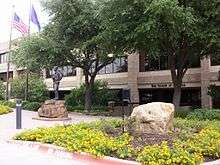
The National Council is the corporate membership of the Boy Scouts of America and consists of volunteer Scouters who meet annually. The day-to-day operations of the National Council are administered by the Chief Scout Executive and other national professional staff. National Council members include volunteers who are elected National Officers and Executive Board members, regional presidents, the local council representatives, members at large, and honorary members. The National Headquarters has been in Irving, Texas since 1979.
Since the founding of the BSA in 1910, the President of the United States has served as the organization's honorary president during his term in office.[84]
Governance and the National Executive Board
The BSA National Executive Board governs the organization. The 2015 National Executive Board consisted of 79 members.[85]
The board is led by the national president, a volunteer elected by the National Council. Board members included regular elected members, regional presidents, and up to five appointed youth members. The Chief Scout Executive is the board secretary and non-voting member. The National Executive Board has a number of standing committees that correspond to the professional staff organization of the National Council.
Present and past members of the National Executive Board include former presidential nominee Mitt Romney,[86] Ernst & Young CEO James Turley and AT&T CEO Randall Stephenson.[87] Other members include LDS Church President Thomas S. Monson.[88]
Groups and divisions
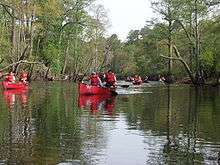
The Program Impact Division is responsible for developing the Scouting program and includes the volunteer committees and staff working on volunteer training, youth development, and other program impact needs. The All Markets membership emphasis includes focus groups and special committees working to improve outreach to youth and families in various underserved ethnic populations, with literature and marketing materials targeting Hispanic/Latino families, Asian-American families, and African-American families. The BSA also participates in the American Indian Scouting Association in partnership with the Girl Scouts of the USA.
The Outdoor Adventure Division oversees four "High Adventure" bases Philmont Scout Ranch, Northern Tier National High Adventure Bases, The Summit Bechtel Family National Scout Reserve, and Florida National High Adventure Sea Base, as well as other special programs and the Order of the Arrow.
Other divisions provides support for the world and national jamborees and International Scouting relations. The Membership Impact Division works to sustain marketing efforts and relationships with the national organizations that make up the predominant number of chartered organizations, such as Lions International, Rotary International, Kiwanis International, American Legion, Elks, VFW, and all religious denominations chartering BSA units.
The National Supply Group is responsible for developing and selling uniforms, apparel, insignia, literature, and equipment. It sells equipment and supplies through National Scout Shops, local council trading posts, authorized independent resellers, and online at ScoutStuff.org. Supply Group also licenses trademarks for use by other commercial vendors. The Administrative Group provides internal administration service and support. It includes the Marketing and Communications Division responsible for marketing the BSA program, administering the national websites, and publishing Scouting for adult leaders and Boys' Life for youth.
The National Scouting Museum is located in Irving, Texas. Exhibits include Norman Rockwell paintings, high adventure sections, hands-on learning experiences, interactive exhibits, and a historical collection tracing uniforms, themes, and documents from the beginning of the Scouting movement in America. Among the museum's artifacts are the Eagle Scout medal of Arthur Rose Eldred, the first Eagle Scout.
The National Court of Honor certifies the BSA's highest awards: lifesaving and meritorious action awards, Distinguished service awards, Eagle Scout and Quartermaster.
Regions and areas
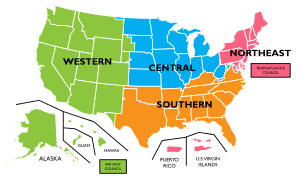
For administrative purposes, the BSA is divided into four regions—Western, Central, Southern and Northeast.[89] Each region is then subdivided into areas.
Each region has a volunteer president, assisted by volunteer officers, board members, and committee members. The day-to-day work of Scouting is managed by the regional director, assistant and associate regional directors, and area directors. Regions and areas are subdivisions of the National Council and do not have a corporate status separate from the BSA.[90]
- Central Region covers all of Iowa, Kansas, Michigan, Minnesota, Missouri, North Dakota, Ohio, Wisconsin, and parts of Illinois, Indiana, Kentucky, Montana, Nebraska, South Dakota, Virginia, and West Virginia.
- Northeast Region covers all of Connecticut, District of Columbia, Delaware, Massachusetts, Maine, New Hampshire, New Jersey, New York, Pennsylvania, Puerto Rico, Rhode Island, Vermont, Virgin Islands (US), parts of Maryland, Virginia, and West Virginia, and members of the BSA Transatlantic Council.
- Southern Region covers all of Alabama, Arkansas, Florida, Georgia, Louisiana, Mississippi, North Carolina, Oklahoma, South Carolina, and Tennessee, and parts of Illinois, Indiana, Kentucky, Maryland, Texas, Virginia, and West Virginia.
- Western Region covers all of Alaska, Arizona, California, Colorado, Hawaii, Idaho, New Mexico, Nevada, Oregon, Utah, Washington, Wyoming, most of Montana, parts of Nebraska, South Dakota, and Texas, territories located in the Pacific Ocean, and members of the BSA Far East Council.
Local councils
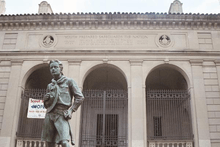
The BSA program is administered through 272 local councils, with each council covering a geopolitical area that may vary from a single city to an entire state. Councils receive an annual charter from the National Council and are usually incorporated as a charitable organization.[89]
The council level organization is similar to that of the National Council. The council executive board is headed by the council president and is made up of annually elected local community leaders.[90] The board establishes the council program and carries out the resolutions, policies, and activities of the council. Board members serve without pay and some are volunteer Scouters working at the unit level. Youth members may be selected to the council executive board according to the council by-laws.
The Scout executive manages council operations—including finance, property management, advancement and awards, registrations, and Scout Shop sales—with a staff of other professionals and para-professionals. Volunteer commissioners lead the unit service functions of the council, help maintain the standards of the BSA, and assures a healthy unit program.[91]
The BSA charters two councils for American Scouts living overseas, largely on military bases in Europe and Asia. The Transatlantic Council, headquartered in Livorno, Italy, serves BSA units in much of Europe, and the Far East Council, headquartered in Japan, serves units in the western Pacific areas. The Direct Service branch makes the Scouting movement available to US citizens and their dependents living in countries outside these jurisdictions or in isolated areas. The Aloha Council in Hawaii also serves BSA units in the American territories of American Samoa, Guam, the Northern Mariana Islands and in the sovereign countries of the Federated States of Micronesia, the Marshall Islands, and Palau.[92]
The Greater New York Councils are unique in that they are divided into five boroughs with each led by a borough Scout executive and each borough then divided into districts. Similarly, due to Scouting population and geographic distance, the Utah National Parks Council is divided into 12 Sectors with each led by a volunteer assistant Vice president and assistant council commissioner with each sector then divided into districts.[93]
Councils are divided into districts with leadership provided by the district executive, district chairman, and the district commissioner.[89] Districts are directly responsible for the operation of Scouting units and, except for the district executive, are mostly staffed with volunteers.[90] The voting members of each district consist of volunteer representatives from each chartered organization having at least one BSA unit, plus annually elected members-at-large who in turn elect the district chairman. Boroughs and districts are subdivisions of the local council and do not have a separate corporate status.[94]
Chartered organizations and units
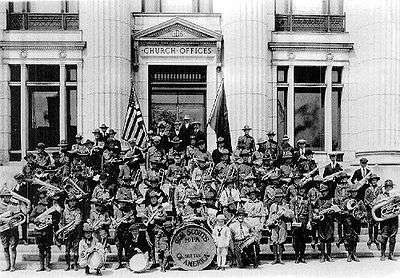
The Boy Scouts of America partners with community organizations, such as religious congregations, fraternal groups, service clubs, and other community associations, to provide the Scouting program for the particular neighborhood or community in which the particular organization wishes to outreach to youth and families. These organizations hold charters issued by the BSA and are known then as chartered organizations. Each chartered organization provides the meeting place for BSA youth, oversees the volunteer leaders, and agrees to follow the basic BSA safety policies and values-based program, and the organization is considered the "owner" of its local program, much like a franchise.
Within each chartered organization, there may be one or more "units". A unit is a group of youth and adults which are collectively designated as a Cub Scout pack, Boy Scout troop, Varsity Scout team, or Venturing crew/Sea Scout ship. Each chartered organization may charter as many units as it wishes, but usually only 3 or 4 (one unit for each program level). The BSA council provides the leader training, inter-unit activities, camping programs, volunteer and professional support, and insurance coverage. Units also create their own activities (such as monthly camping trips, outings, or service projects), and most meet weekly at the place of the chartered organization for youth to learn basic skill development and practice leadership in small groups known as dens and patrols.
| Name of Organization | Total Units (2012 / 2013) | Total Youth (2012 / 2013) |
|---|---|---|
| The Church of Jesus Christ of Latter-day Saints | 37,882 / 37,933 | 420,977 / 437,160 |
| United Methodist Church | 11,078 / 10,703 | 371,491 / 349,614 |
| Catholic Church | 8,570 / 8,131 | 283,642 / 259,297 |
| Parent-teacher groups other than PTAs | 3,712 / 3,076 | 153,214 / 126,207 |
| Presbyterian Church (U.S.A.) | 3,663 / 3,520 | 127,931 / 119,879 |
| Lutheran | 3,902 / 3,728 | 119,701 / 111,483 |
| Baptist | 4,099 / 3,532 | 109,298 / 91,526 |
| Groups of Citizens | 3,445 / 2,633 | 106,852 / 84,497 |
| Private schools | 2,837 / 2,579 | 101,563 / 91,828 |
| Parent-Teacher Association/Parent Teacher Organization | 1,661 / 1,473 | 69,812 / 60,171 |
Finance
The National Council is incorporated as a 501(c)(3) non-profit organization and is funded from private donations, membership dues, corporate sponsors, and special events.[96] In 2005, the BSA ranked as the twelfth-largest non-profit organization in the US, with total revenues of $665.9 million. As of January 2007, the American Institute of Philanthropy listed former Chief Scout Executive Roy Williams as having the fifth-highest compensation of any nonprofit chief in the United States, at $916,028.[97] In 2005, Williams' pay was 0.26% of total expenses, whereas the national average among charities was a higher 0.34%.[98] Williams was honored in 2005 and 2006 as one of the top fifty most effective non-profit leaders by The NonProfit Times.[99]
|
|
The above numbers are for National Council operations and do not include local council income or expenses.
Robert Mazzuca, Chief Scout Executive of Boy Scouts of America, received $1,211,572 in salary and compensation. This is the 4th highest compensation package given by any charity to the head of the charity, according to Charity Watch.[100] Charity Watch rates BSA an "A".[100]
Corporate funding
In addition to donations from individuals, the BSA receives extensive donations from major corporations. In 2010, their top corporate donors were, in order, Intel, Emerson, Verizon, 3M, Bank of America, Wells Fargo, Pfizer, Valero, UPS, U.S. Bank, Eli Lilly, GE, and Monsanto.[101] However, Intel[44] and UPS cut funding to BSA in 2012.[45][46][47]
Impact on American life
Scouting and Boy Scouts are well known throughout American culture. The term "Boy Scout" is used to generally describe someone who is earnest and honest, or who helps others cheerfully; it can also be used as a pejorative term for someone deemed to be overly idealistic.[102]
Prominent Americans in diverse walks of life, from filmmaker Steven Spielberg (who helped launch a merit badge in cinematography) to adventurer Steve Fossett to politicians, were BSA members as youths.[103][104] Over two-thirds of all astronauts have had some type of involvement in Scouting,[105] and eleven of the twelve men to walk on the Moon were Scouts, including Eagle Scouts Neil Armstrong and Charlie Duke.[106][107] The pinewood derby—a wood car racing event for Cub Scouts—has been declared "a celebrated rite of spring" and was named part of "America's 100 Best" by Reader's Digest.[108]
President Gerald Ford said, "I can say without hesitation, because of Scouting principles, I know I was a better athlete, I was a better naval officer, I was a better Congressman, and I was a better prepared President."[109]
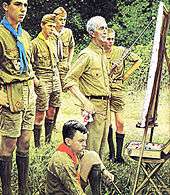
Famed American illustrator Norman Rockwell's works were closely associated with the Boy Scouts of America for much of the 20th century.[110]:43 Beginning in 1913, Rockwell began illustrating covers of Boys' Life, the magazine for BSA youth. He also drew the organization's annual calendar illustrations between 1925 and 1976.[110]:89
In 1969, as a tribute to Rockwell's 75th birthday, officials of Brown & Bigelow and the Boy Scouts of America asked Rockwell to pose in Beyond the Easel for a calendar illustration. As part of the US Bicentennial celebrations in 1976, Rockwell's Scouting paintings toured the nation and were viewed by 280,000 people.[110]:155 In 2008, a twelve-city US tour of Rockwell's works was scheduled.[111]
Alvin Townley wrote in Legacy of Honor about the large positive impact of Eagle Scouts in America. Townley cited such examples as how Scouts, especially Eagle Scouts, were disproportionately represented among Hurricane Katrina's volunteer relief workers; just as they are disproportionately represented among members of the United States Senate.[4]:152 Governor Rick Perry of Texas is an Eagle Scout who defended BSA policies and restrictions against ACLU criticisms in his book, On My Honor: Why the American Values of the Boy Scouts Are Worth Fighting For.[112]
Mark Mays, CEO of Clear Channel Communications, told a magazine interviewer in May 2008 that, "Particularly in the very impactful ages of youth 11 to 14 years old, when they can really go astray and you're taking the time to spend with them and focus on cultural core values like reverent, trustworthy, loyal, and helpful —all of those different things ... Scouting has a huge positive impact on boys and their lives, and that in turn positively impacts our communities and society as a whole."[113]
Mayor of New York City and business tycoon Michael Bloomberg, said that the BSA's Scout Law required of all Boy Scouts—a Scout is trustworthy, loyal, helpful, friendly, courteous, kind, obedient, cheerful, thrifty, brave, clean, and reverent—are "all the American values ... Americans have quaintly simplistic ways and direct ways of phrasing things ... I think it's one of the great strengths of this country."[4]:116
Peter Applebome, an editor of The New York Times, wrote in 2003 of his experience as an adult participating with his son in Scouting activities, "I feel lucky to have had this unexpected vehicle to share my son's youth, to shape it, and to be shaped by it as well."[114] He concluded that, although Scouting is viewed by some as old-fashioned, "Scouting's core values ... are wonderful building blocks for a movement and a life. Scouting's genuinely egalitarian goals and instincts are more important now than they've ever been. It's one of the only things that kids do that's genuinely cooperative, not competitive."[114]:319–320
At the turn of the 20th century, Halloween had turned into a night of vandalism, with destruction of property and cruelty to animals and people.[115] Around 1912, the BSA, Boys Clubs and other neighborhood organizations came together to encourage a safe celebration that would end the destruction that had become so common on this night.[116]
The Boy Scouts of America are quite particular about how and when the Scout uniforms and insignia may be used in film and other portrayals; and for that reason, most films and television productions made in the US utilize "ersatz" Scouting organizations. Examples of this include the "Order of the Straight Arrow", portrayed in the King of the Hill cartoon series, and the "Indian Guides" depicted in the 1995 Chevy Chase film, Man of the House. One exception to this policy is the Walt Disney movie Follow Me, Boys! with Fred McMurray portraying a Scoutmaster of a rural troop. It was released to theaters in 1966 and re-released in 1976. Another is the final scene of The Sopranos television show, where Tony Soprano sits down to dinner in a restaurant. At another table, several Cub Scouts, in full uniform, are seated.
Good Turns
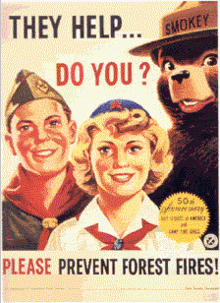
From the inception of the Scouting movement, Scouts have been urged to "Do a Good Turn Daily", as it is the slogan for the Boy Scouts of America. The first national Good Turn was the promotion of a safe and sane Fourth of July in 1912. During World War I, Every Scout to Save a Soldier was a slogan used to motivate children involved in Boy Scouts and Girl Scouts to help sell War savings stamps.[117] Scouting for Food is an ongoing annual program begun in 1986 that collects food for local food banks. In 1997, the BSA developed Service to America with a commitment to provide 200 million hours of service by youth members by the end of the year 2000. As part of Service to America, the BSA provided service projects in conjunction with the National Park Service (NPS). In October 2003, the Department of the Interior expanded the program with the creation of Take Pride in America, opening service to all Americans.[118]
Service to America became Good Turn for America in 2004 and expanded to address the problems of hunger, homelessness, and inadequate housing and poor health in conjunction with the Salvation Army, the American Red Cross, Habitat for Humanity, and other organizations.[119]
Sex abuse cases
Scouting sex abuse cases are situations where youth involved in Scouting programs have been sexually abused by someone who is also involved in the Scouting program. J.L. Tarr, a Chief Scout Executive in the United States, was quoted in the 1980s in an article regarding sexual assault cases against Scout leaders across all 50 states: "That's been an issue since the Boy Scouts began."[120] Several reports have surfaced over the years regarding incidents of sexual abuse within the Boy Scouts of America to include incidents of repeat offenders.[121][122] There have also been several high-profile court cases that resulted in convictions and settlements involving such incidents.[121][122] On October 19, 2012, the Boy Scouts of America were forced by court order to release over 20,000 pages of documentation on 1200 alleged child sexual abuse cases within the organization from between 1965 and 1985.[123]
In the 1980s BSA developed its Youth Protection program, to educate youth, leaders and parents about the problem as a whole, and to introduce barriers to sexual abuse of children using the Scout program to reach victims. "Two deep" leadership dictates that no adult member can be alone with any youth member (other than their own child). Before joining, youth must discuss with their parents a pamphlet on sexual abuse and adults must take youth protection training and, since 2003, new adult members must pass a criminal background check (adults who were already members had to pass a background check by 2008). The Youth Protection Plan from the organization is linked to in a CDC report on such programs.[124]
Anti-bullying movement
Due to reports surfacing in the 1970s and 80s, regarding a high level of bullying in the Boy Scouts, efforts were made to develop a no-tolerance bully policy within the Boy Scouts of America.[125] In the 1990s the Boy Scouts acknowledged that the organization had a problem with bullying, in particular due to a "boys will be boys" attitude within Scouting before the 1970s, when adult leaders tended to overlook younger or weaker scouts who were "picked on" by older boys, such adult leaders feeling that bullying "toughened someone up", labeling boys as "snitches" and "tattletales" should bullying be reported to the adult leadership.[126]
Due to the personal nature of bullying, as well as the act itself not being considered as serious a crime as sexual assault, published media reports of bullying in the Boy Scouts were generally unknown by the public with some rare exceptions. One of the more widely published accounts of Boy Scout bullying occurred in July 1987 when a Boy Scout at the Goshen Scout Reservation was severally beaten in his sleep by several other scouts. The incident resulted in the Goshen staff changing the lay-out of its camp sites, to prevent having sites in extremely isolated areas, as well as assigning camp staff members to each visiting troop as "advisors" and also to watch for fights or other trouble resulting from conflicts developing at the various camp-sites.[127]
In the 21st century, the Boys Scouts have adopted a "Bullying Awareness Program" which trains adults to recognize the signs of bullying, especially in isolated environments such as extended camp-outs in the wilderness or at summer camp. Parents are also advised on what to do, and who to contact, should a Scout state they are being bullied by other scouts. Dealing with the bullies themselves is also addressed, in particular those bullies who "game the system", pretending to be compassionate and apologetic to bully victims when adults confront them, only to return to such behaviors when the adults are no longer present.[128]
References
- ↑ "2015 Treasurer Report" (PDF). Boy Scouts of America. April 11, 2016.
- ↑ "2015 Annual Report" (PDF). Boy Scouts of America. April 11, 2016.
- ↑ The Associated Press. "Boy Scouts' ranks drop after year of policy change". The New York Times. The New York Times. Retrieved July 28, 2015.
- 1 2 3 4 Townley, Alvin (2007). Legacy of Honor: The Values and Influence of America's Eagle Scouts. New York: St. Martin's Press. p. 12. ISBN 0-312-36653-1. Retrieved June 22, 2008.
- 1 2 3 "BSA Vision Statement". U.S. Scouting Service Project. Retrieved July 22, 2008.
- ↑ "Aims of the Boy Scouts of America" (PDF). U.S. Scouting Service Project. Retrieved July 3, 2008.
- ↑ "At a Glance". Boy Scouts of America. 2010. Retrieved June 23, 2010. (Learning for Life numbers are no longer reported)
- 1 2 "Boy Scouts". The New Book of Knowledge. Grolier Online. Retrieved February 24, 2008. (subscription required)
- ↑ Phillips, John Calvin (2001). "Selling America: the Boy Scouts of America in the Progressive Era, 1910–1921" (PDF). University of Maine. Retrieved July 19, 2008.
- 1 2 Macleod, David L. (1983). Building Character in the American Boy: The Boy Scouts, YMCA and Their Forerunners, 1870–1920. University of Wisconsin Press. ISBN 0-299-09400-6.
- ↑ Anderson, H. Allen (1986). The Chief: Ernest Thompson Seton and the Changing West. Texas A&M University Press. ISBN 0-89096-239-1.
- ↑ Beardsall, Jonny (2007). "Dib, dib, dib... One Hundred Years of Scouts at Brownsea". The National Trust Magazine. National Trust for Places of Historic Interest or Natural Beauty (Spring 2007): 525–55.
- ↑ Peterson, Robert W. (1984). The Boy Scouts: An American Adventure. American Heritage. ISBN 0-8281-1173-1.
- ↑ Peterson, Robert W. (2001). "The Man Who Got Lost in the Fog". Scouting. Boy Scouts of America. Retrieved June 24, 2008.
- ↑ Rowan, Edward L (2005). To Do My Best: James E. West and the History of the Boy Scouts of America. Exeter, NH: Publishing Works, Inc. ISBN 0-9746479-1-8.
- ↑ Boy Scouts of America (1911). Boy Scouts Handbook: Original 1911 Edition. pp. 374–5.
- ↑ The National and World Jamborees in Pictures. New York: Boy Scouts of America. 1937. p. 131.
- ↑ Monson, Thomas S. (November 1982). "Run, Boy, Run!". The Ensign. The Church of Jesus Christ of Latter-day Saints. Retrieved January 13, 2011.
- ↑ "Title 36—Patriotic and Natural Observances, Ceremonies, and Organizations" (PDF). Retrieved January 4, 2013.
- ↑ Moe, Ronald C. (April 8, 2004). Congressionally Chartered Nonprofit Organizations ("Title 36 Corporations"): What They Are and How Congress Treats Them (PDF). CRS Report to Congress (Report). Congressional Research Service. Order Code RL30340. Archived from the original (PDF) on October 30, 2008. Retrieved June 17, 2015.
- ↑ Petterchak 2003, pp. 110–111
- ↑ "What is a congressional charter?", Knight Ridder Newspapers, December 12, 2007.
- ↑ "Exclusive right to emblems, badges, marks, and words". Retrieved September 25, 2013.
- ↑ Kosar, Kevin R. "Congressional or Federal Charters: Overview and Current Issues," Congressional Research Service, CRS Report to Congress. Order Code RS22230 (January 23, 2007).
- 1 2 3 Boy Scouts of America Youth Application (PDF). Boy Scouts of America. #28-406B. Retrieved June 27, 2015.
Venturers and Sea Scouts registered in a crew or ship prior to their 21st birthday may continue as members after their 21st birthday until the crew or ship recharters or until they reach their 22nd birthday, whichever comes first.
- ↑ "Sea Scouts, BSA". Sea Scouts, BSA. Retrieved June 28, 2008.
- ↑ "Varsity Letters and Pins". U.S. Scouting Service Project. August 5, 2007. Retrieved July 3, 2008.
- ↑ "Order of the Arrow". Boy Scouts of America. Retrieved February 12, 2015.
- ↑ "About STEM Scouts". Boy Scouts of America. Retrieved September 26, 2016.
- ↑ Brock, Wayne (April 29, 2015). "Boy Scouts CEO: Let's build robots, not fires". USA Today. Retrieved September 26, 2016.
- ↑ "Learning for Life — Exploring". Learning For Life. Retrieved June 24, 2008.
- 1 2 "Learning For Life". BSA Discrimination. Retrieved June 24, 2008.
- ↑ "What Is Exploring?" (PDF). Learning For Life. Archived from the original (PDF) on March 27, 2009. Retrieved June 27, 2015.
- ↑ "Duty to God". BSALegal.org. Archived from the original on May 9, 2008. Retrieved May 25, 2008.
- ↑ "About us". Scouting For All. Retrieved January 4, 2013.
- ↑ "Atheists and Other Freethinkers in Scouting". Scouting For All. Retrieved January 4, 2013.
- ↑ "Gays in Scouting". Scouting For All. Retrieved January 4, 2013.
- ↑ "Litigation". BSALegal.org. Boy Scouts of America. 2006. Archived from the original on December 26, 2006. Retrieved June 27, 2015.
- ↑ "Morally Straight". BSALegal.org. Archived from the original on February 6, 2010. Retrieved May 25, 2008.
- ↑ Crary, David. "Boy Scouts To Review Ban On Gays; No Change Imminent" Huffington Post. AP. June 6, 2012.
- ↑ "Boy Scouts to review ban on gays". Fox News Channel. June 7, 2012. Retrieved November 15, 2012.
- ↑ "After Two-year Evaluation, Boy Scouts of America Affirms Membership Standards and Announces No Change in Policy". Boy Scouts of America. July 17, 2012. Retrieved August 18, 2012.
- ↑ Leitsinger, Miranda (July 17, 2012). "Boy Scouts: We're keeping policy banning gays". NBC News. Retrieved January 4, 2013.
- 1 2 Rogoway, Mike (November 10, 2012). "Intel will end support for Oregon Boy Scouts over Scouts' policy on gays". The Oregonian. Retrieved January 4, 2013.
- 1 2 "UPS stops Boy Scout funding over anti-gay policy". CBS News. November 12, 2012. Retrieved January 4, 2013.
- 1 2 Schulz, Sam (December 11, 2012). "Merck Pulls Boy Scouts Funding Over Anti-Gay Policy". NBC 5 Dallas-Fort Worth. Retrieved January 4, 2013.
- 1 2 Spain, William, "Merck cuts funds to Boy Scouts over antigay policy", MarketWatch, December 10, 2012. Retrieved January 4, 2013.
- ↑ McGregor, Jena (July 19, 2012). "After Boy Scouts of America reaffirms exclusion of gays, the biggest leadership question remains". The Washington Post. Retrieved January 10, 2013.
- ↑ Cobb, Joshua (July 17, 2012). "AT&T CEO commits to ending ban on gay Boy Scouts, leaders". Retrieved January 10, 2013.
- ↑ "Membership Policy" (Press release). Boy Scouts of America. January 28, 2013.
- ↑ "Boy Scouts vote to allow gay youth". Dallas Voice. Retrieved May 23, 2013.
- ↑ "Boy Scouts of America Statement". Boy Scouts of America. May 23, 2013. Retrieved October 2, 2013.
- ↑ "Boy Scouts to allow gay youths to join". CNN. May 23, 2013. Retrieved October 2, 2013.
- ↑ Eckholm, Erik (May 23, 2013). "Boy Scouts End Longtime Ban on Openly Gay Youths". The New York Times. Retrieved October 2, 2013.
- ↑ "So. Baptists Pass Resolution Urging Boy Scouts to Not Repeal Gay Ban by Michael Gryboski of CP". The Christian Post. February 20, 2013. Retrieved October 2, 2013.
- ↑ Ellsworth, Tim (June 12, 2013). "Boy Scout resolution adopted by SBC". Baptist Press. Retrieved October 2, 2013.
- ↑ Payne, Ed (September 9, 2013). "Trail Life USA launches a Boy Scout alternative". CNN. Retrieved February 15, 2014.
- ↑ Lohr, Kathy (September 9, 2013). "Trail Life USA, The 'Other' Boy Scouts Of America". NPR. Retrieved October 2, 2013.
- ↑ "Trail Life USA: An alternative to the Boy Scouts". The Washington Post. September 9, 2013. Retrieved October 2, 2013.
- ↑ "Boy Scouts or an alternative? Churches continue to deliberate". Baptist Press. September 16, 2013. Retrieved October 2, 2013.
- ↑ "Irving-based Boy Scouts of America's executive committee votes to end ban on gay leaders". The Dallas Morning News. Retrieved July 13, 2015.
- ↑ Richter, Marice (July 28, 2015). "Boy Scouts lift blanket ban on gay adult leaders, employees". Reuters. Retrieved July 27, 2015.
- ↑ "Boy Scout Aims and Methods". Meritbadge.com. Archived from the original on October 2, 2013. Retrieved October 2, 2013.
- ↑ "Basic Leader Training". Boy Scouts of America. 2008. Archived from the original on December 12, 2008. Retrieved June 27, 2015.
- ↑ "The Cub Scout Promise The Law of the Pack and The Cub Scout Motto". U.S. Scouting Service Project. August 5, 2007. Archived from the original on July 2, 2008. Retrieved June 28, 2008.
- ↑ "Character Connections". U.S. Scouting Service Project. August 5, 2007. Archived from the original on August 3, 2008. Retrieved July 14, 2008.
- ↑ "Cub Scout Advancement". U.S. Scouting Service Project. November 10, 2007. Retrieved July 14, 2008.
- ↑ "Cub Scout Academics and Sports Program". U.S. Scouting Service Project. November 10, 2007. Retrieved June 7, 2015.
- ↑ "Boy Scout Advancement". U.S. Scouting Service Project. January 17, 2008. Retrieved July 14, 2008.
- ↑ "What is Venturing" (doc). U.S. Scouting Service Project. Retrieved June 28, 2008.
- ↑ "Venturing and Sea Scouting Awards". U.S. Scouting Service Project. August 9, 2007. Retrieved July 14, 2008.
- ↑ "National Jamboree". Time. July 12, 1937. Retrieved September 24, 2008.
- ↑ "The Summit: Bechtel Family National Scout Reserve" (PDF). Boy Scouts of America. Archived from the original (PDF) on July 10, 2012. Retrieved June 29, 2015.
- ↑ A History of Wood Badge in the United States. Boy Scouts of America. 1990. ASIN B0013ENRE8.
- ↑ "Powder Horn Training". Retrieved March 29, 2006.
- ↑ "Sea Scouts BSA: Seabadge". Sea Scouts - Boy Scouts of America. 2003. Archived from the original on June 29, 2012. Retrieved June 29, 2015.
- ↑ "The Youth Leadership Training Continuum: A Guide for Scout Leaders and Parents". Boy Scouts of America. Archived from the original on October 17, 2007. Retrieved June 29, 2015.
- ↑ "Adult". Boy Scouts of America. Retrieved April 30, 2010.
- ↑ "Central Region NLS Page". Central Region, Order of the Arrow, Boy Scouts of America. Retrieved July 3, 2014.
- ↑ National Camping School Resource Center. National Camping School Boy Scouts of America. Retrieved March 5, 2012.
- ↑ National Camping Schools 2012. National Camping School Boy Scouts of America. Retrieved March 5, 2012.
- ↑ "National Camping School". Information Center - Insignia. Boy Scouts of America. 2010. Archived from the original on December 20, 2011. Retrieved June 27, 2015.
- ↑ The Training Times. scouting.org. Spring 2011. Retrieved March 5, 2012.
- ↑ "2007 Report to the Nation". Boy Scouts of Amercica. 2007. Retrieved September 23, 2009.
- ↑ "2015 Treasurer's Report" (PDF). Boy Scouts of America. April 11, 2016. Retrieved September 26, 2016.
- ↑ Burke, Patrick (August 9, 2012). "Romney Says Boy Scouts Should Admit Homosexuals". CNS News. Retrieved January 4, 2013.
- ↑ Hirschfield, Brad (July 20, 2012). "Boy Scouts of America should learn from its own history - For God's Sake". The Washington Post. Retrieved January 4, 2013.
- ↑ "President Monson Discusses Strengths of Scouting". The Church of Jesus Christ of Latter-Day Saints. Retrieved January 4, 2013.
- 1 2 3 Nelson, Bill. "Organization of the Boy Scouts of America". U.S. Scouting Service Project. Retrieved March 12, 2008.
- 1 2 3 Rules and Regulations of the Boy Scouts of America. Boy Scouts of America. 1985.
- ↑ "Commissioners". Boy Scouts of America. 2008. Retrieved July 4, 2008.
- ↑ "Aloha Council". Aloha Council, BSA. Archived from the original on May 1, 2008. Retrieved July 3, 2008.
- ↑ "Utah National Parks Council Executive Board". List of Executive Board Members and Assignments. Utah National Parks Council. Retrieved September 29, 2011.
- ↑ "How the Council Functions to Carry Out the Purpose of the BSA" (PDF). THE COUNCIL. Boy Scouts of America. Archived from the original (PDF) on March 31, 2013. Retrieved February 12, 2013.
- ↑ Boy Scouts of America Fact Sheet. Last updated December 31, 2013. Originally retrieved July 22, 2012 and again April 9, 2014 for comparison.
- 1 2 "Charity Review of Boy Scouts of America". Better Business Bureau. April 2010. Retrieved January 24, 2011.
- ↑ "Top 25 compensation packages". American Institute of Philanthropy. Archived from the original on January 16, 2007. Retrieved June 28, 2008.
- ↑ "NPT's Power and Influence Top 50 2006". The NonProfit Times. August 1, 2006. Archived from the original on December 16, 2007. Retrieved June 27, 2015.
- 1 2 Charity Rating Guide and Watchdog Report, Volume Number 59, December 2011
- ↑ Birkey, Andy (September 18, 2012). "Corporations Giving Big Money to Boy Scouts Despite Antigay Policy". The Advocate. Retrieved January 4, 2013.
- ↑ Simon, Scott (June 14, 2008). "Remembering the Boy Scouts". NPR. Retrieved June 14, 2008.
- ↑ McBride, Joseph (1999). Steven Spielberg. New York: Da Capo Press. p. 43. ISBN 0-306-80900-1.
- ↑ Freeze, Di (October 1, 2007). "Steve Fossett: Always Scouting for New Adventures". Airport Journals. Archived from the original on December 10, 2010. Retrieved July 23, 2008.
- ↑ "NASA and Scouting: A Strong Alliance". NASA. Archived from the original on October 11, 2006. Retrieved March 19, 2008.
- ↑ "Astronauts and the BSA" (PDF). Boy Scouts of America. Retrieved June 24, 2008.
- ↑ Cowing, Keith. "Celestron and Boy Scouts Venture Where NASA cannot (Or will not)". Nasawatch. Retrieved April 27, 2008.
- ↑ "Best Mother-Son Finish". Reader's Digest. 2006. Archived from the original on May 23, 2009. Retrieved February 29, 2008.
- ↑ Rumsfeld, Donald R. "Speech: Boy Scout National Meeting Breakfast As Delivered by Secretary of Defense and Eagle Scout Donald H. Rumsfeld". United States Department of Defense. Retrieved June 24, 2008.
- 1 2 3 Hillcourt, William (1977). Norman Rockwell's World of Scouting. New York: Harry N. Abrams. ISBN 0-8109-1582-0.
- ↑ "Rockwell and Csatari: A tour de force". Scouting: 6. March–April 2008. Retrieved June 22, 2008.
- ↑ Perry, Rick (February 12, 2008). On My Honor: Why the American Values of the Boy Scouts Are Worth Fighting For. Stroud & Hall. ISBN 978-0979646225.
- ↑ "Leading the Way". Scouting: 33. May–June 2008. Retrieved February 13, 2009.
- 1 2 Applebome, Peter (2003). Scout's Honor: A Father's Unlikely Foray Into the Woods. Orlando, FL: Harcourt. p. 325. ISBN 0-15-100592-3.
- ↑ "The New York Institute for Special Education". Nyise.org. Retrieved September 3, 2009.
- ↑ "A Brief History of Halloween in America". DeliriumsRealm. October 9, 2007. Archived from the original on October 23, 2007. Retrieved September 3, 2009.
- ↑ "Wilson Enlists Boy Scouts" (PDF). The New York Times. May 22, 1917. Retrieved September 23, 2009.
- ↑ "Take Pride in America". Department of the Interior. Retrieved June 24, 2008.
- ↑ "Service to America". U.S. Scouting Service Project. Retrieved July 22, 2008.
- ↑ Patrick, Boyle (1991). "Scouts Honor". The Washington Times.
- 1 2 Barrick, Frances (June 26, 2012). "Pain continues for family of boy abused by scout leader". Retrieved August 10, 2012.
- 1 2 Felch, Jason; Christensen, Kim (August 5, 2012). "Boy Scout files reveal repeat child abuse by sexual predators". Los Angeles Times. Retrieved August 10, 2012.
- ↑ Goodale, Gloria. (October 19, 2012) "Boy Scouts child abuse files: Can the organization withstand their release?" MinnPost. Retrieved October 21, 2012.
- ↑ Janet Saul and Natalie C. Audage (2007). "Preventing Child Sexual Abuse Within Youth-serving Organizations: Getting Started on Policies and Procedures" (PDF). U.S. Department of Health and Human Services: Centers for Disease Control and Prevention, National Center for Injury Prevention and Control. pp. 1–55. Retrieved November 18, 2010.
- ↑ Wendel, Ron, "The Scoutmaster Minute: Your Handbook for Inspiring Moments", Gibbs Smith Publishing (2005)
- ↑ Townley, Alvin, "Spirit of Adventure: Eagle Scouts and the Making of America's Future", Thomas Dunne Books (2009), pgs 181, 224-227
- ↑ Intress, R. S. (1987, August 4, 1987). "Boy Scout Beaten at Camp". Richmond Post Dispatch, pp. B-13
- ↑ BSA (January 1, 2016). "Bullying Awareness". Retrieved October 3, 2016.
Further reading
- Block, Nelson R.; Proctor, Tammy M. (2009). Scouting Frontiers: Youth and the Scout Movement's First Century. Cambridge, UK: Cambridge Scholars Publishing. ISBN 1-4438-0450-9.
- Boy Scouts of America (1911). Boy Scouts Handbook: Original 1911 Edition.
- Macleod, David. Building Character in the American Boy: The Boy Scouts, YMCA, and Their Forerunners, 1870-1920 (2004), scholarly history
- Perry, Rick (February 12, 2008). On My Honor: Why the American Values of the Boy Scouts Are Worth Fighting For. Macon, GA: Stroud & Hall. ISBN 0-9796462-2-7., pep talks by a politician
External links
- Boy Scouts of America at DMOZ
- Scouting resources at DMOZ
- Works by Boy Scouts of America at Project Gutenberg
- Works by or about Boy Scouts of America at Internet Archive
- Works by Boy Scouts of America at LibriVox (public domain audiobooks)

- FBI file on the Boy Scouts of America
